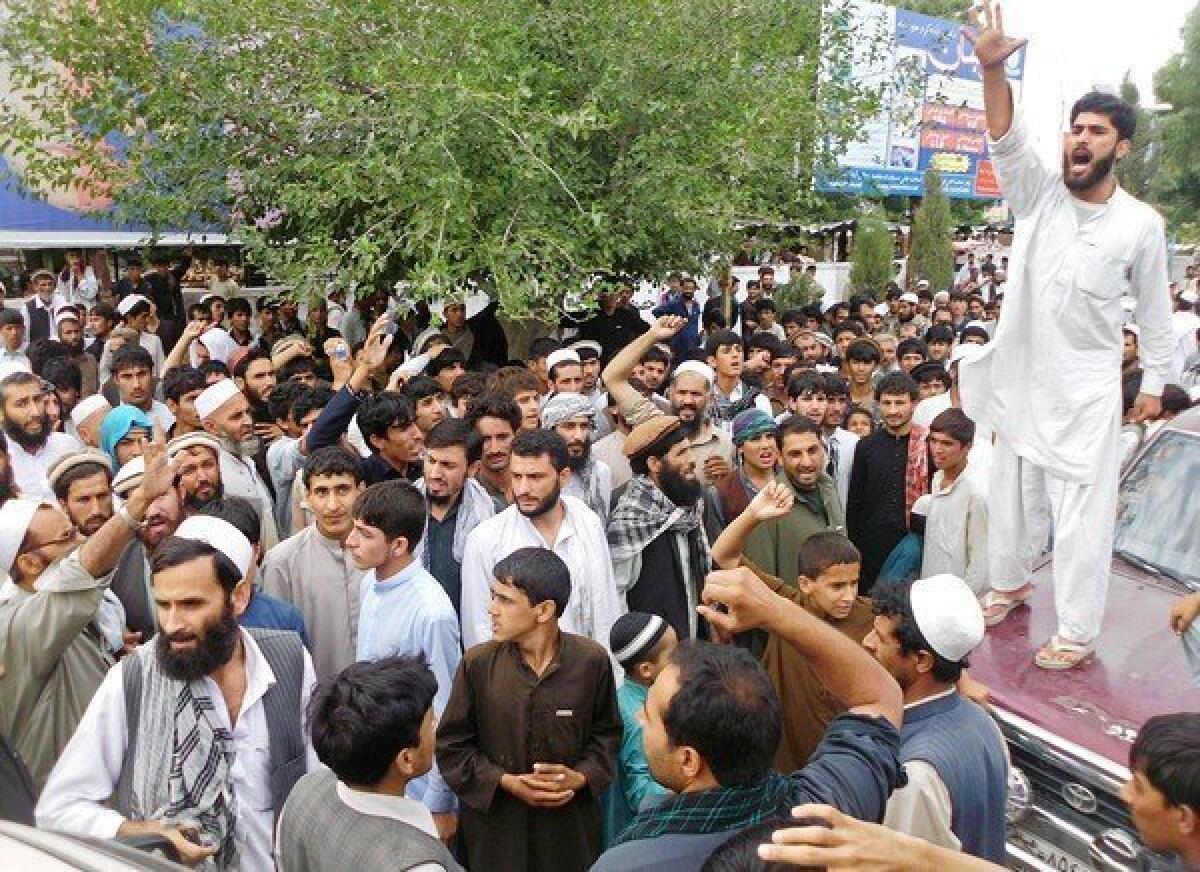NATO disasters stack up in Afghanistan

- Share via
KABUL, Afghanistan — In a disastrous day for the NATO force in Afghanistan, four American troops were gunned down Sunday by Afghan police, a U.S. airstrike killed eight Afghan women foraging for fuel on a rural hillside, and military officials disclosed that a Taliban strike on a southern base had destroyed more than $150 million worth of planes and equipment — in money terms, by far the costliest single insurgent attack in 11 years of warfare.
The confluence of events underscored some of the conflict’s most damaging trends: an unrelenting tide of “insider” attacks, in which Afghan forces turn their weapons on coalition allies; the daily loss of civilian lives to war’s ravages; and the continuing ability of insurgent forces to inflict disproportionate havoc on the far more powerful Western military.
The lethal encounter between U.S. forces and Afghan police took place soon after midnight in Zabol province in the south, military and Afghan officials said. The provincial governor, Mohammad Ashraf Naseri, said the shooting occurred at a joint base in Zabol’s Mezan district.
The NATO force confirmed the deaths without disclosing the nationality, but U.S. officials said the troops were American. The killings came less than 24 hours after two British soldiers were gunned down by an Afghan policeman and brought to 51 the number of Western service members killed this year by Afghan security forces.
Both Western and Afghan officials acknowledge insider shootings have become an extremely serious problem — about 15% of all coalition deaths come at the hands of Afghan forces — and they have taken urgent steps to stop the attacks. Forces on both sides are undergoing cultural training to try to avoid deadly misunderstandings. NATO troops have been ordered to keep rounds chambered in their weapons at all times, and armed Western troops called “guardian angels” have been posted to watch over others in mess halls, sleeping tents and gyms. Thousands of members of a locally recruited village militia were ordered rescreened for links with the insurgency.
How to reduce such attacks is the subject of considerable debate among U.S. and NATO officials. Moves that slow the training of Afghans to take over security in their own country could undercut the goal of a Western military withdrawal from Afghanistan by the end of 2014. And steps seen as too heavy-handed could be taken by Afghans as an insult in a culture where perceived slights can swiftly lead to more violence.
The eight women killed in an airstrike in Laghman province, in eastern Afghanistan, were poor villagers who were gathering brush for cooking fires, provincial authorities said. In addition to those killed, seven people were reported injured. Villagers loaded the bodies into trucks and drove them to the provincial governor’s office, parading them through the streets in protest.
The NATO force acknowledged that five to eight civilians were accidentally killed in a strike targeting a group of insurgents, and expressed regret.
A spokesman for the North Atlantic Treaty Organization coalition, Air Force Capt. Dan Einert, said the bombardment followed a “significant engagement” Sunday morning in the remote Alingar district of Laghman province. He said a unit of NATO’s International Security Assistance Force positively identified a group of about 45 insurgents with hostile intent and called in the airstrike, which killed a large number of them.
“Unfortunately, we are aware of civilian casualties as a result of this strike,” he said.
In recent years, NATO and Afghan government forces have been responsible for a shrinking proportion of civilian deaths, with nearly all such deaths and injuries blamed on insurgents. But airstrikes remain the single largest cause of civilian casualties inflicted by international forces.
Meanwhile, Western officials disclosed early Sunday that an insurgent raid at Camp Bastion, in Helmand province, had been far more serious than initially reported. Military officials had already reported the deaths of two U.S. Marines in the strike that began Friday evening and continued into the early hours of Saturday. On Sunday, however, they reported that the insurgents had managed to destroy six sophisticated AV-8B Harrier jets, together with three refueling stations. Two other Harrier aircraft were “significantly damaged,” as were six soft-skin aircraft hangars.
Bastion, where Britain’s Prince Harry is deployed as part of an Apache helicopter crew, is considered one of the most heavily fortified bases in Afghanistan. That a relatively small squad of insurgents was able to breach the perimeter and inflict such a degree of damage surprised the U.S. and British command.
In London, a Defense Ministry spokesman, speaking under the customary request of anonymity, said Sunday that the prince’s deployment would continue. “In light of this event, there aren’t any plans for him to be withdrawn,” he said.
Times staff writer Henry Chu in London contributed to this report.
More to Read
Sign up for Essential California
The most important California stories and recommendations in your inbox every morning.
You may occasionally receive promotional content from the Los Angeles Times.












